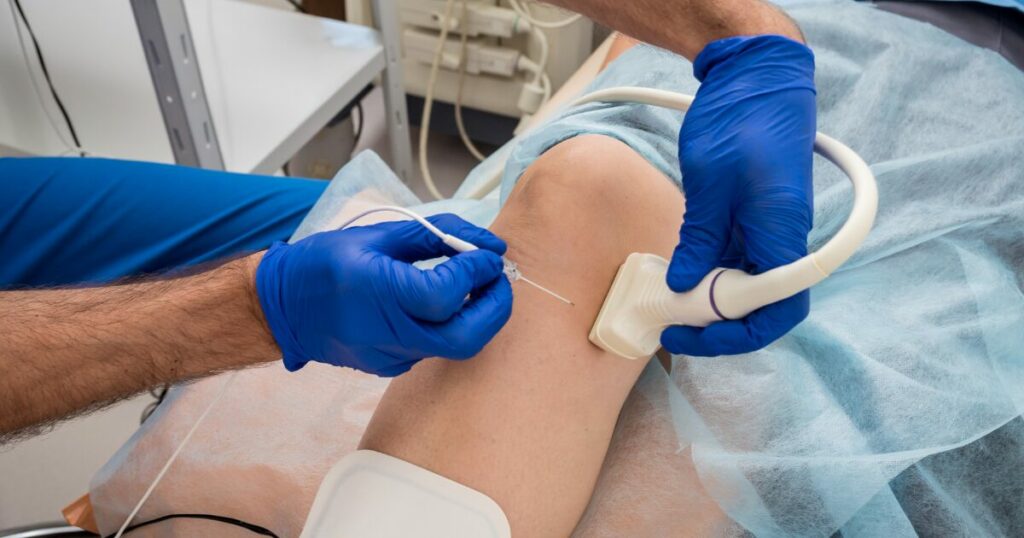In the dynamic landscape of medical advancements, minimally invasive procedures are increasingly becoming the forefront of pain management across various medical disciplines. Among these innovative techniques lies Radiofrequency Ablation (RFA).
In this comprehensive guide, we will delve into what RFA entails, how it is performed, the reasons behind its use, and the associated benefits.
What is the Radiofrequency Ablation Procedure?
Radiofrequency ablation (RFA), is a medical procedure used to treat conditions such as chronic pain, certain cancers, and abnormal heart rhythms (arrhythmias). The technique employs high-frequency electrical currents to generate heat within targeted tissues, thereby eliminating abnormal cells or nerves responsible for pain or irregular heartbeats.
By using radiofrequency energy, a physician can precisely target specific tissues and block their ability to send pain signals without causing extensive damage to surrounding areas.
Who is a Good Candidate for Radiofrequency Ablation?
Determining a patient’s suitability for Radiofrequency Ablation (RFA) involves evaluating several factors, including their medical condition, symptoms, treatment history, and overall health. While the specific criteria may vary depending on the medical indication for RFA, here are some general characteristics that often make a patient a good candidate for the procedure:

Chronic Pain Conditions
Patients experiencing conditions originating from the spine, such as neck pain, joint pain, chronic low back pain, knee pain, pelvic concerns, and peripheral nerve pain, are often good candidates for RFA. It is also used to treat arm and leg pain.
These individuals may have failed to achieve adequate relief with conservative treatments such as pain medication, physical therapy, or steroid injections.
Imaging-Confirmed Lesions
Patients with identifiable lesions or abnormalities on diagnostic imaging studies, such as X-rays, MRI scans, CT scans, or ultrasound, may be suitable candidates for RFA. The presence of well-defined target tissues or tumors that can be visualized and accurately localized on imaging facilitates the precise placement of the radiofrequency probe during the procedure.
[Related: What Causes Tumors? (Guide to Benign & Malignant Tumors)]
Failed Conservative Treatments
Patients who have undergone conservative treatments without significant improvement in symptoms or functional limitations may benefit from RFA. The procedure offers an alternative or adjunctive therapeutic option for individuals who have exhausted non-invasive interventions and continue to experience persistent pain or disability.
Limited Surgical Options
Patients who are poor candidates for traditional surgical interventions due to underlying medical conditions, advanced age, or surgical risk factors may find RFA to be a viable treatment alternative. RFA’s minimally invasive nature and reduced procedural risks make it particularly attractive for individuals who may not tolerate extensive surgery or anesthesia.
Localized Tumors or Lesions
Patients with localized tumors or lesions that are amenable to thermal ablation may benefit from RFA as a curative or palliative treatment option. RFA is commonly used in the management of primary and metastatic tumors affecting organs such as the liver, lungs, kidneys, bones, and soft tissues.
Desire for Minimally Invasive Treatment
Patients who prefer minimally invasive treatment approaches and wish to avoid the potential risks, complications, and prolonged recovery associated with open surgery may opt for RFA. The procedure offers a shorter recovery time, reduced postoperative pain, and fewer cosmetic concerns compared to traditional surgical interventions.
Realistic Treatment Expectations
Patients who have realistic expectations regarding the outcomes, limitations, and potential risks of RFA are more likely to be satisfied with the procedure. Healthcare providers should engage in open and transparent communication with patients, discussing the anticipated benefits, possible side effects, and expected recovery timeline associated with RFA.
How It’s Done

The radiofrequency ablation procedure is typically performed in an outpatient setting. The key steps include the following:
1. Patient Evaluation and Preparation
Before undergoing RFA, patients undergo a comprehensive evaluation by their healthcare provider. This evaluation includes a review of medical history, physical examination, and diagnostic imaging studies such as X-rays, MRI, or CT scans. Patients may be advised to discontinue certain medications or refrain from eating and drinking for a specific period before the procedure.
2. Anesthesia Administration
The RFA procedure typically requires numbing medication such as local anesthesia to numb the area where the catheter or probe will be inserted. In some cases, sedation may also be administered to help patients remain comfortable and relaxed during the procedure.
3. Imaging Guidance
To ensure accurate placement of the RFA probe, imaging guidance techniques such as fluoroscopy, ultrasound, or CT scans are utilized. These imaging modalities allow the healthcare provider to visualize the target tissue in real time and guide the catheter or probe to the precise location.
4. Catheter or Probe Insertion
Once the target area is identified under imaging guidance, the healthcare provider inserts a thin, flexible catheter or probe through the skin and into the target tissue. The insertion site is often numbed with a local anesthetic to minimize discomfort.
5. Confirmation of Placement
After the catheter or probe is inserted, its placement is confirmed using imaging techniques. The healthcare provider ensures that the catheter or probe is positioned accurately within the target tissue, allowing for optimal delivery of radiofrequency energy.
6. Radiofrequency Energy Delivery:
Once the catheter or probe is correctly positioned, radiofrequency energy is delivered through the device. The radiofrequency energy heats the targeted tissue, causing thermal ablation and destruction of the problematic cells or nerves. The duration and intensity of the energy delivery may vary depending on the specific condition being treated and the size of the target area.
7. Monitoring and Adjustment
Throughout the RFA procedure, the healthcare provider monitors the patient’s vital signs and adjusts the energy delivery as needed to ensure safe and effective treatment. Continuous monitoring helps to minimize the risk of complications and ensures optimal outcomes.
8. Post-Procedure Care
After the RFA procedure is completed, patients are monitored for a short period in a recovery area to ensure their stability. In most cases, patients can return home on the same day. They receive instructions on post-procedure care, including recommendations for pain management, activity restrictions, and follow-up appointments.
9. Follow-Up and Monitoring
Following RFA, patients undergo regular follow-up appointments with their healthcare provider to assess treatment outcomes and monitor for any signs of recurrence or complications. Additional imaging studies may be performed to evaluate the effectiveness of the procedure and track changes in the target tissue over time.
Reasons Why It’s Done
- Chronic Pain Management: RFA is commonly used to treat chronic pain conditions such as arthritis, back pain, and nerve pain by disrupting pain signals.
- Cancer Treatment: In oncology, RFA destroys tumors in the liver, kidneys, lungs, and bones, especially for patients who are not candidates for surgery.
- Cardiac Arrhythmias: RFA can correct abnormal heart rhythms by targeting and destroying abnormal electrical pathways in the heart tissue.
Benefits of Radiofrequency Ablation Procedure
Minimally Invasive Procedure
As a minimally invasive procedure, radiofrequency ablation offers patients an alternative to traditional open surgeries. Unlike conventional surgical procedures, RFA typically involves small incisions, reducing trauma to surrounding tissues and minimizing postoperative pain. The use of local anesthesia further enhances patient comfort during the procedure.
Preservation of Healthy Tissue
One of the primary advantages of RFA is its ability to precisely target and destroy diseased tissue while preserving adjacent healthy structures. This targeted approach minimizes collateral damage, reduces the risk of complications, and enhances the overall safety profile of the procedure. By sparing healthy tissue, RFA contributes to faster recovery times and improved patient outcomes.
Customized Treatment Options
RFA offers healthcare providers a high degree of flexibility in tailoring treatment plans to meet individual patient needs. The procedure can be adapted to address a wide range of medical conditions across various anatomical sites, including the spine, liver, lungs, kidneys, and cardiac tissue. This versatility makes RFA a valuable therapeutic tool in the management of diverse clinical scenarios, from chronic pain syndromes to cancerous tumors.
Outpatient Procedure and Reduced Hospitalization
In many cases, RFA can be performed on an outpatient basis, allowing patients to return home on the same day of the procedure. This outpatient approach offers several advantages, including reduced healthcare costs, minimized disruption to daily routines, and enhanced patient convenience. By avoiding prolonged hospital stays, RFA enables patients to resume their normal activities more quickly, promoting a faster return to functional independence.
Effective Chronic Pain Management
Chronic pain conditions, such as facet joint pain, sacroiliac joint dysfunction, and neuropathic pain syndromes, can significantly impair quality of life and functional capacity. RFA serves as an effective pain management strategy by disrupting pain signals transmitted by dysfunctional nerve pathways. By ablating the sensory nerves responsible for transmitting pain signals, RFA provides successful pain relief and improves patient comfort, facilitating greater mobility and engagement in daily activities.
Complementary Therapy and Multimodal Approach
RFA can be integrated into comprehensive treatment plans as part of a multimodal approach to patient care. It may complement other therapeutic modalities, including pharmacological interventions, physical therapy, and interventional procedures, to achieve synergistic effects and optimize treatment outcomes. By addressing multiple aspects of a patient’s condition, RFA enhances the overall efficacy of the treatment regimen and promotes holistic healing.
Minimal Downtime and Rapid Recovery
Compared to traditional surgical procedures, RFA typically involves minimal downtime and rapid recovery. Most patients experience only mild discomfort or soreness following the procedure, which can be effectively managed with over-the-counter pain medications. With proper post-procedural care and guidance, patients can resume their usual activities and gradually increase their level of physical exertion as tolerated.

Answers to Common Questions
How painful is radiofrequency ablation?
Radiofrequency ablation is generally well-tolerated. Patients may experience mild discomfort, but local anesthesia and sedation are often used to minimize pain during the procedure.
Post-procedural discomfort is usually manageable with over-the-counter pain medications.
How long does it take to recover from radiofrequency ablation?
Patients typically experience mild discomfort or cramping for a few days post-procedure. Recovery is generally quick, with patients resuming normal activities within a few days to a week.
Individual recovery experiences may depend on the specific condition being treated and the patient’s overall health.
What are the disadvantages of radiofrequency ablation?
While RFA is generally considered safe, like any medical procedure, it may carry some risks, including infection, bleeding, temporary discomfort, or damage to surrounding structures.
It may not be suitable for all patients, and individual responses vary. Patients should discuss potential risks and benefits with their healthcare provider before undergoing the procedure.
Consult With VISP Today
Radiofrequency Ablation stands as a remarkable advancement in medical science, offering targeted and minimally invasive solutions for a spectrum of conditions. From chronic pain management to oncological interventions and cardiac care, the versatility of RFA is a testament to its efficacy.
As individuals and healthcare practitioners explore the potential of radiofrequency ablation, it is imperative to make informed decisions. Consulting with a qualified healthcare provider is the first step toward understanding how this procedure can address specific health concerns.
VISP provides comprehensive care and expertise in the field of interventional radiology, including radiofrequency ablation procedures. Our team of vein doctors and interventional radiologists is dedicated to delivering personalized, patient-centered care, tailored to meet individual needs and preferences.
Schedule a consultation with our experts today and take the first step towards improved health and well-being.
